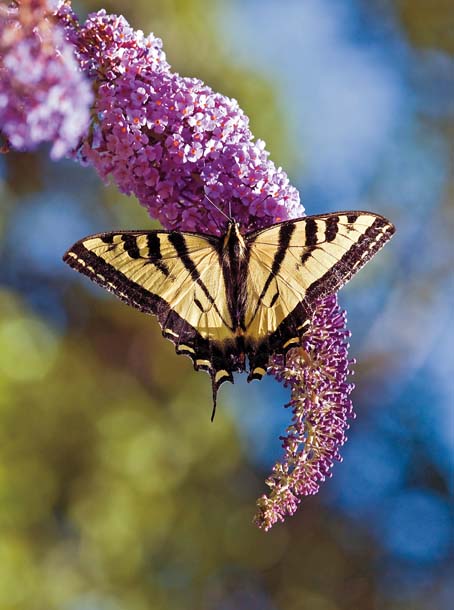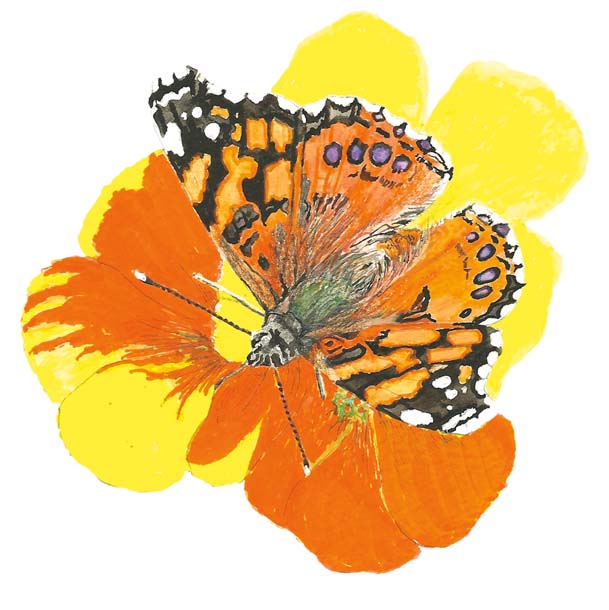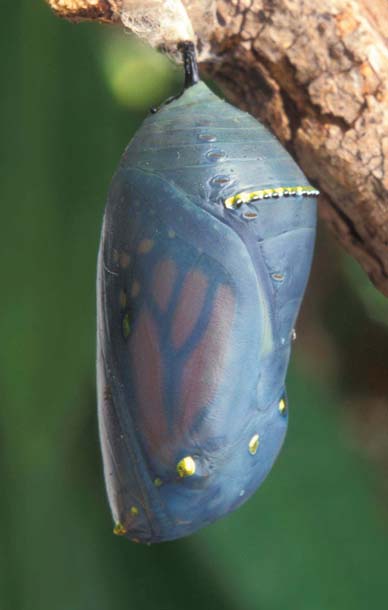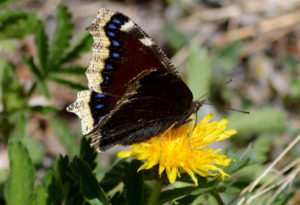For Jan Southworth, it began with monarchs. When she was an East Bay Regional Parks naturalist at Ardenwood Historic Farm near Fremont in the 1990s, she led tours to the eucalyptus grove where a population of monarch butterflies spends the winter. “People were in a state of rapture,” she recalls. “It was almost like a religious experience.”
As an environmental educator, Southworth had been struggling to find ways to engage children with the natural world: “So many children who came to the regional parks on field trips were frightened of dirt, insects, and wildlife. Butterflies are universally appealing and nonthreatening. I realized I could use the study of butterflies and the creation of a nectar garden to introduce children to the park in a gentle way.”
When she transferred to Coyote Hills Regional Park in 1996, Southworth decided to create her butterfly garden near the headquarters there. “The garden started mostly with monarchs and milkweeds,” she says. “It was a trial-and-error process.”
Butterflies will feed on nectar from a variety of plants, but females typically lay their eggs on only one or a few plant species. The Coyote Hills garden offers ceanothus, lupine, and buckwheat as host plants. There’s also California pipevine for the pipevine swallowtails and coffeeberry for the pale swallowtails.
Before the garden, Southworth saw few butterflies at the park headquarters except passing monarchs. The plantings now attract at least 16 species, six of which are laying eggs on the host plants. And it’s alive with hummingbirds and native bees.
- Western tiger swallowtail on Buddleja (butterfly bush) at the Coyote Hills Regional Park butterfly garden. Buddleja attracts many pollinators with its nectar-rich blossoms. Photo (c) Scot Goodman, scotgoodman.smugmug.com.
Southworth also hoped to inspire schools and homeowners to create their own butterfly refuges: “Biologists are concerned with creating corridors of habitat through the urban environment. If I plant my butterfly garden but there’s nothing else within three miles, it’s like a desert oasis. We hoped to connect the dots.” Teachers responded, convincing school administrators to convert turf into pollinator gardens: “We helped plant about 12 school gardens from Morgan Hill to Bay Farm Island.”
Southworth, who retired five years ago, calls the garden’s creation “one of the most satisfying parts of my career with the park district.” Teachers she worked with still bring milkweed plants to Coyote Hills, so monarchs can lay eggs on them, providing portable “raise and release” science lessons for classrooms.
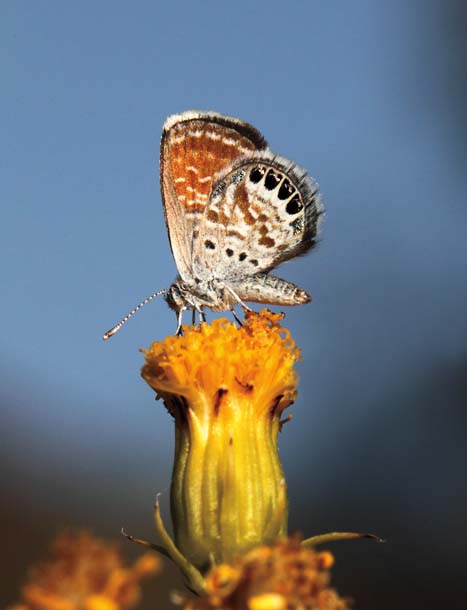
- Sometimes less than half an inch across, the western pygmy blue is the smallest butterfly in the western United States. Photo by Paul G. Johnson, closer2nature.com.
Southworth is just one in a long line of people–scientists, amateur naturalists, artists, writers, at least one prospector–who have fallen for butterflies. Pierre Joseph Michel Lorquin came to California in the 1850s in search of gold. What he found instead was butterflies. The state’s first known lepidopterist, Lorquin is known to have collected in the Bay Area, although none of his field notes or letters has survived.
Few have expressed their passion for butterflies as eloquently as novelist Vladimir Nabokov, who pursued them near Los Altos Hills: “[T]he highest enjoyment of timelessness . . . is when I stand among rare butterflies and their food plants. This is ecstasy, and behind the ecstasy is something else, which is hard to explain. It is like a momentary vacuum into which rushes all that I love.”
Their beauty and grace are compelling; even drab satyrs and skippers have a quiet elegance. And it helps that the number of butterfly species is not overwhelming. California’s total is approximately 240, compared with our state’s 4,500 named moth species or 8,000-plus beetle species.
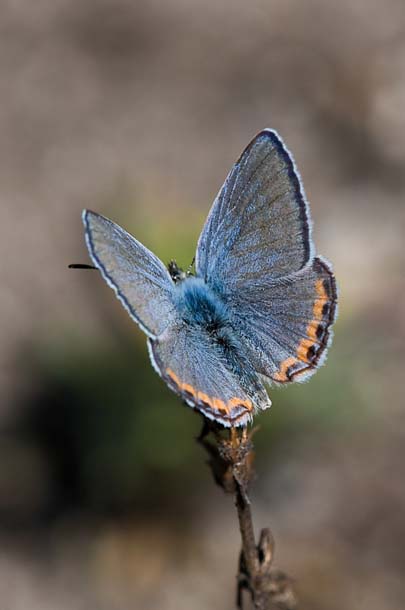
- Look for acmon blues around Berkeley, which racked up the nation’s highest count for this species in 2009. Photo (c) Scot Goodman, scotgoodman.smugmug.com.
Moreover, each butterfly species has its own story: epic journeys, symbiotic relationships, protective chemicals borrowed from host plants.
Take the blue-black pipevine swallowtail, a regular at Southworth’s garden. As a caterpillar, it eats nothing but pipevine leaves, which are loaded with toxic aristolochic acid. A larva doesn’t just digest the toxin: It sequesters it in its body. In all its life stages–egg, caterpillar, and adult–it’s unpalatable to birds and other predators. As warning signals, the eggs are brick red, and the larvae are black with rows of orange-red “horns.”
Some butterflies aren’t toxic but mimic others that are. The California sister, another Coyote Hills visitor, and Lorquin’s admiral (Pierre Lorquin’s namesake) both have upper-wing patterns of white diagonals on a dark background and orange forewing tips. It’s been speculated for decades that the admiral might mimic the sister, whose larvae feed on oak leaves and might be chemically defended. In 2001, researchers fed both species to captive western scrub-jays. The birds ate the admirals with apparent relish, but swallowed the sisters reluctantly and “exhibited feather ruffling and bill wiping” afterward–generally bird language for “yecch.”
Jan Southworth’s passion for butterflies was expressed in gardening. Liam O’Brien, an actor and artist, went through his own metamorphosis from curious observer to conservationist. He was new to California when he met a stray western tiger swallowtail in San Francisco’s Duboce Triangle. Intrigued, he bought a field guide and signed up for the Berkeley Fourth of July Butterfly Count. “That was like being the ball boy wandering into center court at Wimbledon,” he says. “The best way to learn is to just be the guy with the clipboard.” He’s now a regular on the Berkeley and Mount Diablo counts and heads up the annual count in San Francisco.
The annual count is an important tool for monitoring butterfly populations and distribution. Every summer, several thousand observers–academics, amateurs, and home-based garden-watchers from all over the continent–survey designated circles 15 miles in diameter. The North American Butterfly Association publishes an annual summary, a sort of State of the Butterflies report.
UC Berkeley professor emeritus Jerry Powell, a moth expert who calls himself “not really a butterfly person,” has worked the Berkeley count for its entire 36 years. “There’s a lot of continuity of people taking part, some for 15 or 20 years,” he says. The Berkeley count circle includes Wildcat, Tilden, and Redwood regional parks and Huckleberry Regional Preserve. The Mount Diablo circle takes in Black Diamond Mines along with Mount Diablo State Park and Antioch Dunes National Wildlife Refuge.

- A prolific painter of butterflies (his American lady is below), Liam O’Brien is working to improve San Francisco’s butterfly habitat by encouraging the use of host plants in residential yards. Photo by Margo Bors.
In 2009, the most recent year for which data is available, 42 butterfly species were tallied on Berkeley’s count, 32 on Mount Diablo’s. Mount Diablo had the highest numbers nationally for the gorgon copper (215) and rural skipper (345); Berkeley led in golden hairstreaks (12), acmon blues (117), and mylitta crescents (181). “Two areas that are productive on the count are Redwood Canyon, particularly the upper parts, and the trail down from Sibley,” Powell says. “We can see 20-some species in a day in either of these localities. We also see about that many in Briones Regional Park and down along the reservoir.”
“In the 1980s we averaged 45 species a day in Berkeley,” Powell says. “In the first half of the ’90s that slipped to 43; in the next five years, to 39. All subsequent counts averaged 40 or so. The average hasn’t continued to decline past the early ’90s but clearly represents some loss of diversity compared with the ’80s. We’re also seeing fewer individuals of a lot of species.”
Habitat loss doesn’t seem to explain the diversity decline. “We selected parks from the get-go,” recalls Powell. “As a generalization, I don’t think the [butterflies in] parks are declining more than in other areas.” One ironic exception: the Berkeley Marina in Eastshore State Park, now a magnet for birds but not butterflies. “It was a waste area when we started, with lots of weedy vegetation,” says Powell. “They’ve graded it for wetlands. We used to see pygmy blues along the edge of the Bay there. We also saw the eufala skipper, but haven’t seen it in many years. Marble butterflies used to be common there, feeding on weedy mustard. We still see it, only one or two at a time.”
Powell speculates the trend may reflect “the interplay between habitat fragmentation and in some cases the drying of habitat.” But there’s no obvious smoking gun. “Global warming is not the answer for things around here,” he says.
O’Brien is doing his own bit for butterfly diversity by restoring habitat for the mission blue and coastal green hairstreak in San Francisco, where he’s encouraging homeowners to plant nectar sources and host plants. He also knows the East Bay well. I asked him about butterfly hot spots in the East Bay Regional Parks.

- A Sonora blue’s wings are “like electric blue tinfoil.” Photo (c) John Hendrickson/Larry Ulrich Stock.
“Let’s start with Sunol Regional Park,” he says. “It’s the only really good place to see our most beautiful small butterfly in the U.S., the Sonora blue.” Blues, Nabokov’s favorites, were likened by lepidopterist John Adams Comstock to “bits of summer sky that have dropped to earth.” The Sonora may be the ultimate blue. “Its wings look like electric blue tinfoil,” says O’Brien. “It’s beyond shimmering. It’s an early-emerging butterfly that pops out in January–a true harbinger of spring. What’s cool about the Sonora blue is that you wait all winter in the cold and gloom and you get so rewarded when you look at it. It’s gone by March.” It frequents rocky areas along Sunol’s main trails, wherever its host plant, the native succulent dudleya, grows.
Starting in June, says O’Brien, Jewel Lake in Tilden Regional Park is a prime location for two cryptically patterned anglewing butterflies, the common satyr anglewing and the rarer oreas anglewing. “The oreas is found in shady dappled sunlight. They like to fly in and out of sun and shade.” The oreas is believed to lay its eggs on a native gooseberry. Adults nectar on tansy ragwort and mints and are attracted to flowing sap.
Farther south in the East Bay hills, Huckleberry Regional Preserve is O’Brien’s go-to spot for the enigmatic golden hairstreak. Adults emerge from their chrysalides only once a year. “There’s only one flight, from early June into July,” he says. “You have to look for its host, the golden oak [aka canyon live oak]. At emergence, the whole tree is alive with fluttering hairstreaks.” But don’t bother looking for it on flowers. “I have never met anyone who claimed to have seen them visit flowers,” writes UC Davis’s Arthur Shapiro, coauthor of the Field Guide to Butterflies of the San Francisco Bay and Sacramento Valley Regions. “I once had a student sit in the midst of a large colony of these insects for several weeks, trying to find out what the adults eat. She never saw one feed at all.”
Also in summer, O’Brien recommends looking in Diablo Range canyons for the spectacular two-tailed swallowtail, relatively uncommon here: “It’s just a jaw-dropper–like a big bird. They go up and down trails from early May to at least September.” To Comstock, the two-tailed was “our most regal [swallowtail], powerful in flight and disdainful of the approaches of the lepidopterist.”

- Monarchs nectar on a variety of plants but lay eggs only on milkweed. Photo by Jocelyn Knight, jocelynknight.com.
Sonora blues and two-tailed swallowtails may be the connoisseur’s prizes, but to most of us the prime example of charismatic minifauna is the monarch, arguably the most recognizable, most-studied, and best-loved North American butterfly. It was the monarchs of Ardenwood that showed Jan Southworth how butterflies could be a gateway to a heightened intimacy with nature.
Monarchs are solar-powered animals. “On a cold overcast day they may not get out of their cluster at all,” says Ardenwood naturalist Christina Garcia. “As soon as the sun hits a cluster they do this wonderful thing called a cascade: They all warm up and fly at once.”
No one knows for sure how long monarchs have been wintering at Ardenwood. Garcia has pored over the records of the farm’s founders, who planted the eucalyptus trees where the butterflies roost: “We have the journals of Clara Patterson, who had a lot of interest in nature. The Pattersons had carvings of dragonflies and other insects on their house. If these wonderful butterflies had been within 200 yards of her estate, she would have known about it. But we’ve found nothing in the whole family history.”
According to Garcia, the monarch congregations were first reported after the park district took over the property in the mid-1980s: “That was after the wild creeks around Fremont and Union City had been channelized, taking out hundreds of trees that would have been perfect shelter.”

- A monarch caterpillar at Ardenwood Historic Farm in Fremont. Photo by Debbi Brusco, moonlittrails.com.
To Garcia and the rest of the Ardenwood staff, the reviled eucalyptus is actually a valuable resource, and a threatened one at that: Its Australian predators have caught up with it. The first arrival was a beetle, the longhorn eucalyptus borer. “Then another insect, the lerp psyllid, showed up.” There’s no effective biological control yet for the psyllid, a scale-like sap-sucker, or for the tortoise beetles that eat the edges of the eucalyptus leaves. “We’ve had to cut down a whole bunch of trees. We’re also planting a lot of eucalyptus–the only park in the district that plants them. We’re using a shorter, fatter subspecies that’s resistant to some of the bugs.”
Despite the plantings, the annual Thanksgiving monarch counts have recently recorded smaller and smaller assemblages. Totals fell from 25,000 in 1997 to a nadir of 182 ten years later. Southworth reported a maximum of 235 on the 2010 count, although Garcia says she had estimated 400 to 500 earlier in the season. “The population has really dropped a lot in California since 1997,” says Garcia; one study reported a 92 percent decrease from 1997 to 2002. “There’s a lot of speculation: maybe it’s because of drought or habitat destruction, or milkweed being affected by herbicides used on Roundup-ready crops.”
Arthur Shapiro describes a “catastrophic” collapse of monarch numbers along his transect of monitoring sites, running from Suisun Bay to the Sierra, and says the species no longer breeds in the Sacramento Valley. He discounts herbicides (in California, milkweed doesn’t grow among farm crops) and drought (nothing like the current decline was observed in the dry years of the ’70s and ’80s). “There is no obvious loss of host plant in the places I go,” he writes. “But there is a lot of early [larval] mortality due to . . . what? At Suisun this fall I watched a female flying along the railroad tracks laying on almost every milkweed shoot. Ten days later I could not find a single larva!”
Other scientists, like Shawna Stevens and Dennis Frey at California Polytechnic State University, make an explicit connection between drought and monarch declines across the West. Drought stress on milkweed, they reported last year, “reduces milkweed germination, survivorship, growth, and seed production. . . . Milkweed plants with low water availability often have more viscous latex, which can make leaf eating more difficult for larvae, which may lead to declines in larval survival.”

- Oreas anglewing butterfly, which lepidopterist Liam O’Brien says is found in shady areas with dappled sunlight. Photo by Ron Wolf.
Louie Yang, Shapiro’s colleague at UC Davis, is also focusing on climate change. “There’s a rising potential for mismatch in the timing of monarch-milkweed interactions,” he says. “Is a young plant too small? Is an older plant too tough?”
Whatever is going on, it’s sobering to realize that the iconic monarch may be in trouble. And not just monarchs: butterfly species richness has declined at half of Shapiro’s 10 monitoring sites. As scientists continue to search for explanations, there’s room for amateurs to join seasonal counts, help restore habitat, or simply plant some buddlejas and milkweeds at home.
It’s easy to feel powerless in the face of many environmental issues, from climate change to global loss of biodiversity, but, says Southworth, “With a nectar garden, you can teach and have people take that learning home and enhance habitat in their own personal gardens.” That benefits a suite of native pollinators, from bees to butterflies, and brings a touch of color into people’s daily lives at the same time.
To learn about volunteering at Coyote Hills’ nectar garden, contact Naturalist Beverly Ortiz at bortiz@ebparks.org or (510)544-3216. Look for brochures on butterflies and butterfly gardening at park visitor centers and at ebparks.org/activities/naturalists.

.jpg)
